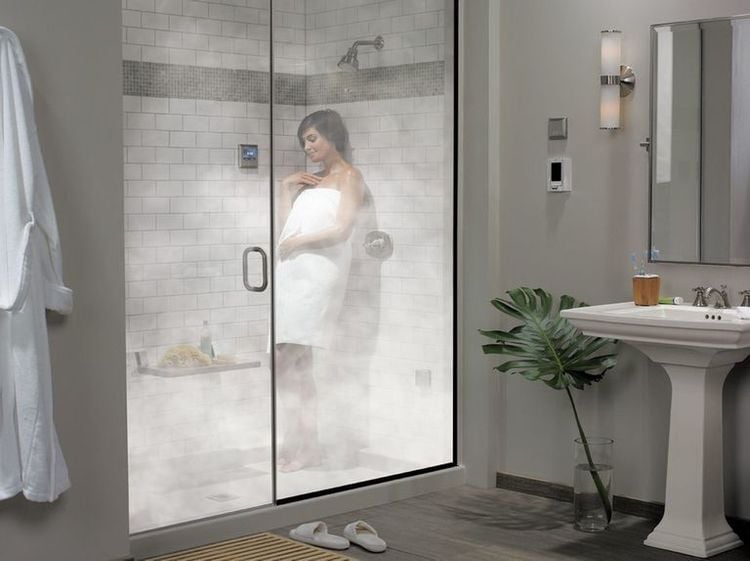This is an automatically translated article.
Sauna has been used throughout history for its powerful health benefits. In fact, saunas can boost your health in a number of ways, including promoting improved circulation, stress relief and brighter skin, and more. Read more to understand the benefits of saunas.1. What is the effect of sauna?
There are a number of health benefits associated with a steam room, each of which is described here.Improves Circulation Sitting in a steam room has been shown to have beneficial effects on the cardiovascular system, especially in older people. One study of older adults found that moist heat improved circulation, especially in the extremities. Improved circulation can lead to lower blood pressure and a healthier heart. It can also promote the healing of damaged skin tissue.
A 2012 study found that moist heat, such as the moist heat provided by a steam room, can improve circulation by dilating small blood vessels or capillaries. After that, it is possible to circulate blood most easily and transport oxygen throughout the body. Steam bath therapy has also been shown to lower blood pressure and keep the heart healthy, as well as help restore ulcerated skin tissue from wounds, such as ulcers.
Lowers blood pressure Research Trusted Source shows that in a steam room, some people's bodies secrete hormones that change their heart rate. One of these hormones, called aldosterone, helps regulate your blood pressure. When aldosterone is released from sitting in a steam room, it can help lower high blood pressure. This is part of the reason a steam room feels so relaxing.
Reduce stress Staying in a steam room can also reduce the body's production of cortisol. Cortisol is the hormone that regulates how much stress you feel. When your cortisol levels drop, you feel more in control and relaxed. Spending a few minutes in a state of relaxation not only improves health, but also heals the mind and improves concentration. Being in the heat of a steam room can cause the body to release endorphins, known as "feel-good" hormones because they help reduce feelings of stress in the body.

Trong phòng xông hơi ướt, cơ thể một số người tiết ra hormone làm thay đổi nhịp tim của họ
Sauna therapy used to treat colds and sinus infections at home is controversial because of the potential for burns if you do it incorrectly. But compared to a steam room, it's relatively safe, as long as you don't stay indoors for too long. An older studyTrusted Source conducted on a group of children found that children with respiratory infections recovered faster after saunas than children who did not use sauna therapy. . Steam rooms break up congestion in the sinuses and lungs, so can be used to help treat colds, clear sinus congestion, and aid breathing. However, do not use the online room if you have a fever.
Promotes Skin Health When exposed to the environment, all kinds of toxins can be trapped underneath your skin. Steam rooms help solve that problem by using heat to open up your pores. The warm steam helps wash away dirt and dead skin that can lead to breakouts. As a result, you can have a clearer and more even skin tone. Both a steam room and a sauna will cause a person to sweat from the heat. Sweating opens up your pores and helps clean your outer skin.
The warm steam will help wash away the dirt and dead skin that has been used during the acne treatment. What a steam room doesn't do, however, is help remove toxins trapped beneath the skin.
Aids in exercise recovery The pain you feel after a workout is known as late-onset myalgia (DOMS). Professional athletes have known for decades that heat therapy can help them recover from exercise. Heat can penetrate deep into muscle tissue and help relieve late-onset muscle pain. A recent study found that moist heat works more effectively and faster than dry heat in muscle recovery. Usually, after a workout, a person's muscles will feel sore. This pain is known as late-onset myalgia, and it's important that you relax your muscles to promote a quick and healthy recovery.

Phòng xông hơi ướt giúp giải quyết vấn đề về làn da bằng cách sử dụng nhiệt để mở các lỗ chân lông của bạn
Loosen stiff joints Warming up before exercise is very important to avoid injury. Using a steam room as part of a warm-up can help you achieve maximum mobility during activities like running, Pilates, and yoga. A Trusted Source study investigated the effects. Heat is applied to the knee joint prior to activity, and the result is a much more flexible and relaxed joint. Results show that heat can help reduce pre-workout injuries. It has also been found that women especially benefit from heat therapy on the knee joint to prevent injury. A steam room can also be used before a workout, as it relaxes joints and increases flexibility, much like a warm-up before a workout. A 2013 study found that applying heat to a joint can reduce the force needed to move a joint by up to 25% compared to applying cold. Steam rooms can also help relieve joint pain.
Burn calories When you are in a steam room or sauna, your heart rate will increase. If you use a steam room after aerobics, your heart rate is already elevated, and a steam room can prolong that elevation. When used correctly, experts note that saunas and steam rooms stimulate your body in ways that conventional exercise doesn't. Sweating in a steam room is not a tool for quick weight loss. Any weight you lose in the steam room is water weight and you will need to replace it by drinking water to avoid dehydration. But using a steam room regularly as a way to burn more calories at the gym can make your diet and exercise routine more effective.

Sử dụng phòng xông hơi ướt thường xuyên sẽ giúp tăng khả năng miễn dịch trong máu và có thể khiến bạn ít bị ốm hơn
Boosts Immune System Various forms of hydrotherapy are known to boost immunity and steam rooms are no exception. Exposure to your body in warm water stimulates white blood cells, which are cells that fight infection. However, sitting in a steam room while you're battling a cold shouldn't be your first line of defense, as there's no evidence that steam can kill an infection when brewing beer. However, using a steam room regularly will help boost immunity in your blood and may make you less likely to get sick.
2. Limitations and risks of using a steam room
Steam rooms have a lot of potential health benefits, but they can be harmful if you overuse them. Staying in a steam room for more than 15 minutes can dehydrate you. Steam rooms can also harbor other people's germs. The steam is not hot enough to kill some bacteria, and the warmth can even increase the number of bacteria.Steam baths alone cannot treat serious conditions. And while they can get your heart rate up and make your workouts more effective, steam rooms are no substitute for exercise. If you are pregnant, have a weakened immune system, or are recovering from surgery, avoid using steam rooms and saunas until you have received clear information from your doctor.

Phòng xông hơi ướt có rất nhiều lợi ích sức khỏe tiềm ẩn, nhưng chúng có thể gây hại nếu bạn lạm dụng chúng
3. What is the difference between a sauna and a sauna?
A steam room and a sauna are similar as both are heated rooms used for relaxation and to help relieve the symptoms of certain medical conditions. However, there is a difference between these two.The main difference is that while steam rooms are filled with moist heat, saunas provide dry heat from a wood or electric stove. The sauna room is paneled with wood and the stove heats up the stone, thereby radiating heat into the enclosed room. Sometimes there will be a small amount of steam in the room if the user puts the water on the hot stone.
The temperature in a sauna is usually higher than in a steam room at around 160°F to 200°F, while the humidity is much lower at between 5% and 30%.
A steam room is similar to a sauna. Both encourage you to sit in a small, heated room, and both claim that your health will benefit. The big difference is in the type of heat they provide. Saunas use dry heat, usually from hot stones or an enclosed stove. The steam room is heated by a generator filled with boiling water. While a sauna can help relax and loosen your muscles, it won't have the same health benefits as a steam room. The key to the unique health benefits of a steam room is humidity.
Hope the above information has provided you with more options and answers about what saunas do. Wish you always have a scientific diet and improve your work productivity and improve your life.
Please dial HOTLINE for more information or register for an appointment HERE. Download MyVinmec app to make appointments faster and to manage your bookings easily.
Reference sources: healthline.com, medicalnewstoday.com












